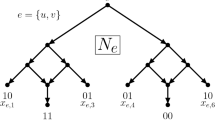Abstract
In phylogenetics, a central problem is to infer the evolutionary relationships between a set of species X; these relationships are often depicted via a phylogenetic tree—a tree having its leaves labeled bijectively by elements of X and without degree-2 nodes—called the “species tree.” One common approach for reconstructing a species tree consists in first constructing several phylogenetic trees from primary data (e.g., DNA sequences originating from some species in X), and then constructing a single phylogenetic tree maximizing the “concordance” with the input trees. The obtained tree is our estimation of the species tree and, when the input trees are defined on overlapping—but not identical—sets of labels, is called “supertree.” In this paper, we focus on two problems that are central when combining phylogenetic trees into a supertree: the compatibility and the strict compatibility problems for unrooted phylogenetic trees. These problems are strongly related, respectively, to the notions of “containing as a minor” and “containing as a topological minor” in the graph community. Both problems are known to be fixed parameter tractable in the number of input trees k, by using their expressibility in monadic second-order logic and a reduction to graphs of bounded treewidth. Motivated by the fact that the dependency on k of these algorithms is prohibitively large, we give the first explicit dynamic programming algorithms for solving these problems, both running in time \(2^{O(k^2)} \cdot n\), where n is the total size of the input.



Similar content being viewed by others
References
Aho AV, Sagiv Y, Szymanski TG, Ullman JD (1981) Inferring a tree from lowest common ancestors with an application to the optimization of relational expressions. SIAM J Comput 10(3):405–421
Bininda-Emonds OR (2004) Phylogenetic supertrees: combining information to reveal the tree of life, vol 4. Springer Science & Business Media, Berlin
Bininda-Emonds OR, Gittleman JL, Steel MA (2002) The (super) tree of life: procedures, problems, and prospects. Annu Rev Ecol Syst 33:265–289
Bodlaender HL, Drange PG, Dregi MS, Fomin FV, Lokshtanov D, Pilipczuk M (2013) An \(O(c^k n)\) 5-approximation algorithm for treewidth. In: Proceedings of the IEEE 54th annual symposium on foundations of computer science (FOCS), pp 499–508
Bryant D, Lagergren J (2006) Compatibility of unrooted phylogenetic trees is FPT. Theor Comput Sci 351(3):296–302
Cayley A (1889) A theorem on trees. Q J Math 23:376–378
Cygan M, Nederlof J, Pilipczuk M, Pilipczuk M, van Rooij JMM, Wojtaszczyk JO (2011) Solving connectivity problems parameterized by treewidth in single exponential time. In: Proceedings of the IEEE 52nd annual symposium on foundations of computer science (FOCS), pp 150–159
Davies TJ, Barraclough TG, Chase MW, Soltis PS, Soltis DE, Savolainen V (2004) Darwin’s abominable mystery: insights from a supertree of the angiosperms. Proc Natl Acad Sci 101(7):1904–1909
Delsuc F, Brinkmann H, Philippe H (2005) Phylogenomics and the reconstruction of the tree of life. Nat Rev Genet 6(5):361–375
Diestel R (2010) Graph theory, vol 173, 4th edn. Springer, Berlin
Felsenstein J (2004) Inferring phylogenies. Sinauer Associates, Incorporated. http://books.google.fr/books?id=GI6PQgAACAAJ
Fitzpatrick DA, Logue ME, Stajich JE, Butler G (2006) A fungal phylogeny based on 42 complete genomes derived from supertree and combined gene analysis. BMC Evol Biol 6(1):1
Frick M, Grohe M (2004) The complexity of first-order and monadic second-order logic revisited. Ann Pure Appl Log 130(1–3):3–31. doi:10.1016/j.apal.2004.01.007
Gordon AD (1986) Consensus supertrees: the synthesis of rooted trees containing overlapping sets of labeled leaves. J Classif 3(2):335–348
Kloks T (1994) Treewidth, computations and approximations. Lecture notes in computer science, vol 842. Springer, Berlin
Lokshtanov D, Marx D, Saurabh S (2011) Lower bounds based on the exponential time hypothesis. Bull EATCS 105:41–72. http://albcom.lsi.upc.edu/ojs/index.php/beatcs/article/view/96
Maddison W (1989) Reconstructing character evolution on polytomous cladograms. Cladistics 5(4):365–377
Ng M, Wormald NC (1996) Reconstruction of rooted trees from subtrees. Discret Appl Math 69(1–2):19–31
Scornavacca C (2009) Supertree methods for phylogenomics. Ph.D. thesis, Université Montpellier II-Sciences et Techniques du Languedoc
Scornavacca C, van Iersel L, Kelk S, Bryant D (2014) The agreement problem for unrooted phylogenetic trees is FPT. J Graph Algorithms Appl 18(3):385–392
Steel M (1992) The complexity of reconstructing trees from qualitative characters and subtrees. J Classif 9:91–116
Acknowledgements
This work has been partially funded by the French Agence Nationale de la Recherche, Investissements d’avenir/Bioinformatique (ANR-10-BINF-01-02, Ancestrome).
Author information
Authors and Affiliations
Corresponding author
Additional information
An extended abstract of this work appeared in the Proceedings of the 11th International Conference on Algorithmic Aspects of Information and Management (AAIM), pages 53–64, volume 9778 of LNCS, Bergamo, Italy, July 2016.
Rights and permissions
About this article
Cite this article
Baste, J., Paul, C., Sau, I. et al. Efficient FPT Algorithms for (Strict) Compatibility of Unrooted Phylogenetic Trees. Bull Math Biol 79, 920–938 (2017). https://doi.org/10.1007/s11538-017-0260-y
Received:
Accepted:
Published:
Issue Date:
DOI: https://doi.org/10.1007/s11538-017-0260-y




